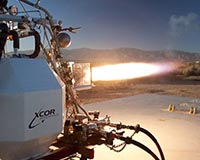 |
Huntsville AL (SPX) Sep 08, 2009 Engineers at NASA's Marshall Space Flight Center in Huntsville, Ala., responsible for developing propulsion elements for the Orion crew capsule's Launch Abort System passed a major milestone Aug. 31 with the completion of Orion's Preliminary Design Review. The Launch Abort System is the critical element of the Orion capsule that will pull its crew safely away from the Ares I rocket in the event of an emergency. Orion is the next-generation spacecraft designed to carry astronauts to the International Space Station and other destinations. The Marshall Center provides government oversight of the motors that power the Launch Abort System, and has a supporting role in thermal, structures, mechanisms, avionics, systems engineering, flight testing and ground operations. The Preliminary Design Review is an early, comprehensive review of the space vehicle's design, preceding the detailed design process. The Launch Abort System includes three motors: an abort motor that pulls the Orion capsule from danger; an attitude control motor to provide directional control; and the jettison motor that separates the system from the crew module. In the event of a launch failure, the main abort motor will ignite, producing more than a half-million pounds of thrust within milliseconds, and will pull the Orion capsule away from the launch vehicle. Once the crew module has been reoriented for landing, the Launch Abort System will be jettisoned, and parachutes will slow the capsule's descent to a safe landing. To better understand how a Preliminary Design Review works, consider the process of designing a house. At this preliminary stage in the process, the homeowner typically would schedule a meeting with the architect to review the designs, ensuring that everything is proceeding as planned. The buyer then would inspect the plans to better understand how all the framing, plumbing, electricity and exterior materials fit together, thereby building confidence in the plans. The buyer needs to know that all these systems will work cohesively when built. Cost and schedule also would be addressed. If all this information is acceptable to the buyer, the architect moves forward with the final design. There are similarities in building a house to designing motors for a launch system intended to pull a spacecraft crew to safety. Approximately 50 people across the Orion LAS team took part in documentation reviews to ensure the system design is safe and meets all NASA requirements. The team identified potential gaps in the design and addressed ways to reduce those gaps as the design goes forward. The next major review the Orion LAS team is working toward is the Orion Critical Design Review, scheduled for February 2011. That milestone will demonstrate that the Launch Abort System's design is mature and ready for full-scale fabrication, assembly, integration and testing. A full-scale test of the launch abort system, or Pad Abort 1, is scheduled early next year at the U.S. Army's White Sands Missile Range. This test will be the first full-scale test flight of the new system, simulating an emergency abort scenario from the launch pad, using a full stack of Orion and the launch abort system. Development of the Orion launch abort system is being led by the Exploration and Flight Projects Directorate at Langley Research Center in Hampton, Va., on behalf of the Orion Project located at Johnson Space Center in Houston. Share This Article With Planet Earth
Related Links ATA Engineering Rocket Science News at Space-Travel.Com
 XCOR Powers Up The Lynx 5K18 Rocket Engine Test Program
XCOR Powers Up The Lynx 5K18 Rocket Engine Test ProgramMojave, CA (SPX) Sep 03, 2009 XCOR Aerospace reports that it has reached several significant milestones in the 5K18 rocket engine test program. This is the engine that powers XCOR's Lynx suborbital spacecraft. The engine can be seen running in several newly released videos including a video demonstrating the very stable "shock diamond" pattern visible in the engine's supersonic exhaust. "Like all of our rocket engines, ... read more |
|
| The content herein, unless otherwise known to be public domain, are Copyright 1995-2009 - SpaceDaily. AFP and UPI Wire Stories are copyright Agence France-Presse and United Press International. ESA Portal Reports are copyright European Space Agency. All NASA sourced material is public domain. Additional copyrights may apply in whole or part to other bona fide parties. Advertising does not imply endorsement,agreement or approval of any opinions, statements or information provided by SpaceDaily on any Web page published or hosted by SpaceDaily. Privacy Statement |